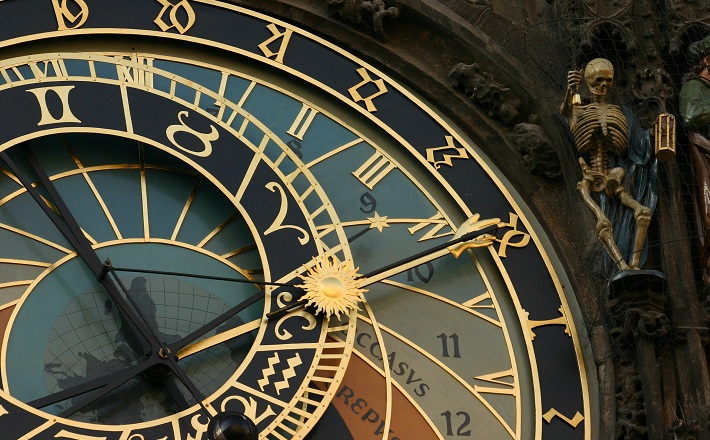Commentary on Matthew 24:36-44
When Advent wreaths are given nice, little weekly themes, they risk domesticating the radical nature of the lectionary readings for the season.
Moreover, they often turn Advent into pre-Christmas. But the beginning of the liturgical year is anything but sweet, and it does much more than prefigure the Nativity. On the First Sunday in Advent, the church begins its new year celebration by focusing on the End (with a capital E) with the expectation of Jesus’ final coming to us.
Every year the gospel reading comes from one of the Synoptic eschatological discourses set in Jerusalem after Jesus has left the temple, predicted the temple’s destruction, and been asked by the disciples about when/how the prediction will be fulfilled.
But Jesus does not just talk about the temple. He leapfrogs to talk about the end of the cosmos, the end of history … as we know it. With figurative, apocalyptic, and mythological imagery, the Evangelists present Jesus as interpreting the meaning of the Parousia.
Matthew’s version of the eschatological discourse is a significant expansion of Mark 13. Most obvious is the fact that after the bulk of material taken from Mark (in Matthew 24:1-36) Matthew adds material with a particular eschatological interpretation. This material includes four eschatological parables—faithful servant, ten bridesmaids, talents, judgment of the nations (24:45-25:46). The foundation for those parables is laid in the gospel lection for Advent 1. The comparison of the Parousia to the story of the Great Deluge in Noah’s day is unique to Matthew and key to understanding the First Gospel’s particular eschatological vision.
Scholars generally assume the author of the First Gospel wrote his narrative in the last quarter of the first century (circa 80) and that part of his agenda was to reassert an eschatological expectation among his readers after some fifty years of waiting for Jesus to return without it occurring. To be more precise, while the evangelist does likely want to reinforce a literal expectation of the return of the son of the human, his deeper concern is with shaping the lives of those in his church so that they practice an eschatological existence in the present.
For Matthew, it is not that Jesus’ first coming was historical and his second coming will be eschatological. No, the birth, ministry, death, and resurrection comprise an eschatological event that means the church is already living and always will live in the turning of the ages. The End has begun. Matthew strives to answer the question: how are we to live in-between “the already” of the salvation we have experienced in Christ and the “not yet” of that salvation not being fully consummated in the world? The key to Matthew’s answer lies in the comparison of the Parousia and the Flood when read in the wider context of what follows in the eschatological discourse.
The apocalyptic schemas which get the most attention in today’s culture are the sorts found in 2 Thessalonians and Revelation and popularized in contemporary writing like the Left Behind series. Essentially that schema asserts that when the rapture occurs, Jesus will take the faithful with him and the unfaithful (the damned) will be left behind. Matthew’s schema, however, is the complete reverse of this. As the Great Flood took away the unfaithful and left behind the faithful, so too will be the coming of the son of the human (Matthew 24:39). Two will be in a field. The unfaithful one will be taken away, and the faithful will remain. Two will be working in a mill: the unfaithful one will be taken away and the faithful one will be left behind.
Matthew is thinking metaphorically here, not literally. He is not predicting what will actually happen at the Parousia. He is describing current eschatological existence using future eschatological imagery. Living faithfully in the already-not yet of Christian discipleship does not mean that we can rest on God’s grace. It means that God gives us all the more responsibility for doing God’s will on earth as it is done in heaven. The faithful ones left behind in the field and the mill now have added work.
Matthew makes this concept more explicit and unpacks it further in scenes of contrast that follow our lection.
- Jesus contrasts a slave who is faithful while the master is gone and is rewarded with more responsibility with the unfaithful slave who faces apocalyptic judgment of weeping and gnashing of teeth (Matthew 24:45-51).
- Jesus contrasts the ten wise bridesmaids who brought enough oil to accompany the groom with the foolish ones who were unprepared and are abandoned when the bridegroom arrives (25:1-13).
- Jesus contrasts slaves faithful in managing five and two talents being rewarded with double responsibility with the slave unfaithful in managing one talent who faces apocalyptic judgment of weeping and gnashing of teeth (25:14-30).
- And finally Jesus contrasts the righteous who feed the hungry, give drink to the thirsty, welcome the stranger, clothe the naked, care for the sick and visit the imprisoned with the unrighteous who do not. Those who fail receive eternal punishment. And the righteous? They are left behind to inherit the reign of God … where there is more work to be done! (25:31-46)
To preach Matthew 24:36-44, preachers will have to present this unique view of Matthew’s slowly and deliberately. What little most of our congregations know about New Testament eschatology runs counter to Matthew’s schema. It is important, therefore, in the exegetical elements of the sermon to use the full context of Matthew’s eschatological discourse.
Preachers, however, cannot stay in the ancient world. What does this eschatological view mean for today? Preachers need to paint a picture of what eschatological existence looks like today. To do this, preachers will also have to overcome the natural way some people will hear Matthew’s claim that eschatological existence means more responsibility. Some hearers’ first response will be to think of this added responsibility as a burden.
For Matthew, however, it is a gift from God. Having already been transformed by the Christ-event, the church is invited to participate in the transformation of the world yet still in process! In the Lord’s Prayer, Jesus teaches us to ask that God’s reign come, that God’s will be done on earth as it is in heaven. In the eschatological discourse, Jesus gives us the opportunity to partner with God in answering that prayer.
Want a picture of Matthew’s metaphorical vision of the Parousia, of true eschatological existence? Offer hearers a vision of the church at work in the not yet places of the world. Places where justice and equality have not yet been found. Places where hunger and thirst have not yet been alleviated. Places where school children die of senseless violence. Places where the planet is not yet being treated with respect. Show the church beginning to make a difference in places such as these and you will offer your hearers Matthew’s vision of what it looks like to be waiting expectantly for the coming of Christ in the Parousia.


December 1, 2019